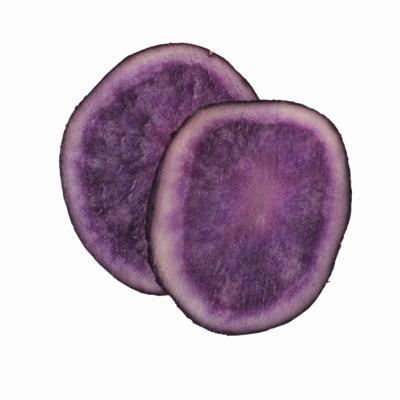 Purple Okinawan sweet potatoes may look different from more common varieties of sweet potatoes, but they’re just as nutritious, if not moreso. Common in Asia, the vegetable is beginning to catch the eye of such Western medical experts as Mehmet Oz, M.D., who dubbed it a “Top 5 Superfood for 2010.” The potato may be hard to find in the United States, but with research verifying its health benefits, it’s worth tracking down.
Purple Okinawan sweet potatoes may look different from more common varieties of sweet potatoes, but they’re just as nutritious, if not moreso. Common in Asia, the vegetable is beginning to catch the eye of such Western medical experts as Mehmet Oz, M.D., who dubbed it a “Top 5 Superfood for 2010.” The potato may be hard to find in the United States, but with research verifying its health benefits, it’s worth tracking down.
Identification
The Okinawan sweet potato is also called the Hawaiian purple sweet potato or simply “imo.” It’s native to the Japanese island of Okinawa, although it’s also grown in other Asian countries. A member of the morning glory family, the potato thrives in deep, volcanic soil with up to 120 inches of annual rainfall. About 1.3 million pounds of the sweet potatoes are grown each year, an amount expected to increase as demand rises, according to the company Hawaii Pride. The Okinawan sweet potato is sometimes confused with other varieties, but the Okinawan potato has a pale tan skin and lilac-colored flesh.
Nutrition
One cup of Okinawan purple sweet potatoes has approximately 140 calories, 2 g protein, 32 g carbohydrates, 4 g fiber and less than one-half gram of fat. A serving also contains 30 g, or one-half your daily Recommended Daily Allowance of vitamin C, 19 mcg folate and traces of other B vitamins. Minerals include 271 mg potassium, 29 mg calcium, 37 mg phosphorus, 17 mg sodium, 13 mg magnesium, and traces of iron, zinc, copper, manganese and selenium. The purple pigment contains high levels of anthocyanin, an antioxidant. (References 1)
Benefits
People in Japan have used the Okinawan sweet potato to treat diabetes due to its low ranking on the glycemic index scale, used to measure how fast a food is likely to raise your blood sugar. Its beta carotene, or vitamin A, can help improve your immune system, preserve eyesight and fight infections. The antioxidants the potato contains have been linked to a reduction in your risk factor for cardiovascular disease and cancer. The Okinawan sweet potato has 150 percent more antioxidants than blueberries.
Expert Insight
Researchers in Japan at the Daiyu-kai Institute of Medical Science fed rats a combination of purple sweet potato color and red cabbage. Their findings, published in the February 2002 issue of the “Journal of Toxicological Sciences,” showed that the purple sweet potato suppressed the development of colorectal tumors. The Okinawan sweet potato was also found to protect against liver injuries in mice in a study published in 2010 in “Food and Chemical Toxicology,” and to have properties preventing arterial plaque buildup in a study published in 2010 in the “Journal of Medicinal Food.”
Uses
The Okinawan sweet potato has a delicate, slightly sweet taste and a creamy texture and can be used like other sweet potatoes, baked, boiled, fried, roasted or grilled. The potatoes are easier to come by on the West coast of the United States and in Asian markets, where you should look for potatoes that are firm and small to medium in size, avoiding any that have wrinkled skins, soft or brown spots or sprouts. Due to a high sugar content, you should store the potatoes in a well-ventilated, dark, dry place and use them within two weeks.
URL: http://www.livestrong.com/article/338669-okinawan-sweet-potato-nutrition/
